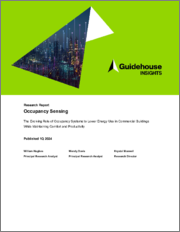
많은 빌딩 자동화 시스템(BAS)은 서비스 지역에 사람이 있는지, 얼마나 많은 사람이 있는지에 대한 정확한 정보가 있으면 적은 전력으로 적절한 수준의 편안함과 효율성을 유지할 수 있습니다. 이것은 스마트 온도 조절기가있는 가정에서 확립된 애플리케이션이며 점유 센서는 상업용 조명 시스템의 표준 기술입니다. 그러나 지능형 빌딩에서는 지능형 HVAC 애플리케이션이 아직 널리 보급되지 않았습니다. 성장하고 있는 활용 분야로는 점유률 데이터를 사용하여 데스크 호스팅을 위한 공간 계획 개선, 실제 사용량에 따른 화장실 청소 등 건물 유지보수 일정 최적화를 지원하는 것 등이 있습니다. 또한, 정확한 가동률 정보는 시설의 기밀 구역에서 직원의 출입을 허가, 제한, 모니터링하는 건물 출입 및 보안 시스템 성능의 핵심이 됩니다.
다양한 BAS의 운영 데이터를 통합 운영 시스템에 연결함으로써 빌딩은 BAS를 동기화하고 빌딩 관리 시스템(BMS)을 통해 테넌트에게 더 나은 서비스를 제공할 수 있게 됩니다. 이러한 연계를 통해 빌딩에서 소비되는 에너지를 절감할 수 있으며, 각 BAS는 서비스 수요를 예측하기 위해 협력할 수 있습니다. 이 시나리오는 오늘날에도 가능하지만, 대부분의 점유 시스템이 BAS 분야에만 사용되기 때문에 거의 실행되지 않고 있습니다. 안타깝게도 이러한 성장 지연은 당분간 지속될 것으로 보입니다.
본 보고서에서는 세계 상업 빌딩용 점유 시스템 시장을 분석하고, 점유 센서의 활용 영역 실현과 관련된 사업 사례, 기회, 판매 채널, 도입 과제 등 시장 과제에 대해 조사하고 있습니다. 또한, 향후 시장 수익 전망(2033년까지)을 용도별, 지역별로 예측하고 있습니다. 또한, 점유 시스템 관련 주요 기술 및 경쟁 상황도 조사하고 있습니다.
Many building automation systems (BAS) can maintain a suitable level of comfort and efficiency with less power when they have accurate information on whether people are present in the served area, and how many. This is an established application in homes with smart thermostats, and occupancy sensors are standard practice for commercial lighting systems. However, the intelligent HVAC application has not attained much traction in intelligent buildings. Applications that are growing include using occupancy data to improve space planning for desk hoteling and to help buildings optimize maintenance schedules, such as cleaning restrooms based on actual usage. Also, accurate occupancy information is central to the performance of building access and security systems that allow, restrict, and monitor employee access in a facility's sensitive areas.
Tying occupancy data from the various BAS into a consolidated occupancy system would enable a building to synchronize its BAS to offer tenants better service through the building management system (BMS). Such coordination could lower energy consumed by the building, and the respective BAS could coordinate to anticipate requests for service. This scenario is possible today, but rarely implemented, as most occupancy systems are used in BAS siloes. Unfortunately, this slow growth seems likely to continue for the time being.
This Guidehouse Insights report analyzes the global market for occupancy systems for commercial buildings. It provides an analysis of the market issues, including business cases, opportunities, sales channels, and implementation challenges associated with implementing occupancy sensor applications. Global market forecasts, which are provided for revenue, broken out by application, and by region, extend through 2033. The report also examines the key technologies related to occupancy systems and the competitive landscape.